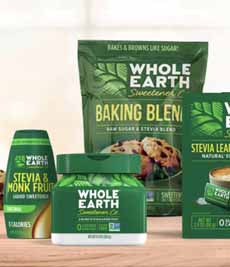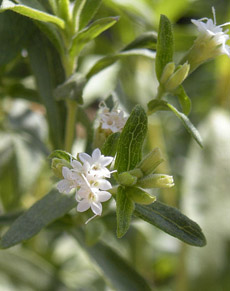TOP PICK OF THE WEEK: Whole Earth Stevia Leaf & Monk Fruit Sweetener
|
We have been using noncaloric sweeteners for decades, starting with zero-calorie soda brands in middle school, then on cereal and other foods as packets of the sweetener became available. While we’ve tried every brand over the years, our reigning favorite was Splenda (sucralose), introduced to the U.S. in 1999. Not only did it have less of an aftertaste, but it was heat-stable for cooking and baking. We’ve tried other sugar substitutes, most recently including monk fruit and stevia leaf. We gave a thumbs down to both. While we recognize that the choice of sugar substitute is very specifically attuned to one’s palate (we have friends who still prefer Sweet ‘N Low saccharin), we came across a new blend that’s worth a try to those who aren’t perfectly happy with their sugar substitute. Splenda had started to taste more and more artificial to us in hot drinks—largely coffee and tea, but also hot cocoa. Did our palate change somehow? Did Splenda change the percentages of its ingredients? Is the main ingredient, sucralose, somehow different now? We don’t know; but for the past year we’ve been sweetening our tea with one packet of Splenda and one packet of sugar (16 calories, 2 g sugar) to provide the sweetness, while minimizing the aftertaste. The combination is O.K., but not perfect. So when we were offered a sample of Whole Earth Stevia Leaf & Monk Fruit Sweetener, zero calories, we accepted (photos #1 and #2). And we’re glad we did. While we didn’t like stevia and monk fruit individually, they work magic together. We prefer it in our our coffee and tea, and find it equally good on cereal and baked apples (our regular sweet treat). If you dip a finger into the powder to taste it straight, you’ll be pleasantly surprised. We haven’t made brownies or cake yet—largely because we have an unfortunate tendency to eat the whole thing. But people who have baked Whole Earth sweetener really like it. Whole Earth Stevia Leaf & Monk Fruit Sweetener, which we’ll abbreviate to WESLMF, has a crystalline appearance, plus: The ingredients are erythritol, stevia leaf extract, natural flavors* and monk fruit extract. The product is available in packets, in jars of loose product, as a liquid, in “sugar” cubes, and Baking Blend. The basic product works best in beverages, salad dressings, sauces and sprinkling. Each packet of WESLMF is equivalent in sweetness to 1.5 teaspoons of sugar. Baking Blend (photo #3) has non-caloric bulking agents that give WESLMF enough body to substitute for sugar in recipes, and properties that bake and brown like sugar†. All of the ingredients exist in nature. |
|
|
|
________________ *Natural flavors are ingredients that come from nature, e.g. blueberry extract. The term “natural flavor” is defined by the U.S. Food & Drug Administration Code of Federal Regulations, 21 CFR 101.22(a)(3). In this Whole Earth sweetener, you will not taste any flavor in the product; only sweetness. †All powdered sugar substitutes contain bulking agents. That’s because the sweetening ingredients are so tiny (e.g., 300 times the sweetness of sugar), that there would be hardly anything to put in a packet.
|
||








